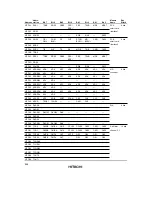
433
Item
Symbol
Min
Typ
Max
Unit
Test
Conditions
Erasing
Wait time after
SWE bit setting
*
1
x
1
—
—
µ
s
Wait time after
ESU bit setting
*
1
y
100
—
—
µ
s
Wait time after
E bit setting
*
1,
*
6
z
—
—
10
µ
s
Erase time
wait
Wait time after
E bit clearing
*
1
α
10
—
—
µ
s
Wait time after
ESU bit clearing
*
1
β
10
—
—
µ
s
Wait time after
EV bit setting
*
1
γ
20
—
—
µ
s
Wait time after
H'FF dummy
write
*
1
ε
2
—
—
µ
s
Wait time after
EV bit clearing
*
1
η
4
—
—
µ
s
Wait time after
SWE bit clearing
*
1
θ
100
—
—
µ
s
Maximum number
of erases
*
1,
*
6
N
—
—
100
Times
Notes: 1. Follow the program/erase algorithms when making the time settings.
3. Programming time per 128 bytes. (Indicates the total time during which the P bit is set
in flash memory control register 1 (FLMCR1). Does not include the program-verify time.)
3. Time to erase one block. (Indicates the time during which the E bit is set in FLMCR1.
Does not include the erase-verify time.)
4. Maximum programming time
t
P
(max) =
Σ
wait time after P bit setting (z)
N
i=1
5. The maximum number of writes (N) should be set as shown below according to the
actual set value of (z) so as not to exceed the maximum programming time (t
P
(max)).
The wait time after P bit setting (z) should be changed as follows according to the
number of writes (n).
Number of writes (n)
1
≤
n
≤
6
z = 30 µs
7
≤
n
≤
1000
z = 200 µs
(Additional programming)
Number of writes (n)
1
≤
n
≤
6
z = 10 µs
6. For the maximum erase time (t
E
(max)), the following relationship applies between the
wait time after E bit setting (z) and the maximum number of erases (N):
t
E
(max) = Wait time after E bit setting (z)
×
maximum number of erases (N)
Summary of Contents for H8S/2670
Page 5: ......
Page 9: ......
Page 199: ...182 ...
Page 361: ...344 ...
Page 393: ...376 ...
Page 647: ...630 ...
















































